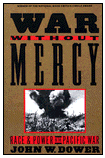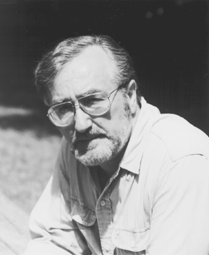A book review of War Without Mercy, Race and Power in
the Pacific War (Pantheon 1987)

 The author, John W. Dower (1938-
) is a Harvard-trained East Asian historian, currently teaching at Massachusetts Institute
of Technology. He published this book in 1986 at the height of Japan's dominance in the
world economy when "Japan-bashing" was in vogue as American car manufacturers
struggled to regain a competitive advantage in the world market. During the early 1980s,
Professor Dower noticed that much of the anti-Japanese language had origins in the Second
World War when racist language dominated the popular and U.S. government-sponsored press.
In this book, Dower traces the stereotypes portrayed by the press and government sponsored
propaganda machines in both countries, Japan and the U.S., to show how our mutual
perceptions helped influenced policymaking and military strategy during and even after the
war. I found the book to be very useful in revealing an underlying world of cross-cultural
perception, or misperception, looking back fifty-plus years since the end of the war.
The author, John W. Dower (1938-
) is a Harvard-trained East Asian historian, currently teaching at Massachusetts Institute
of Technology. He published this book in 1986 at the height of Japan's dominance in the
world economy when "Japan-bashing" was in vogue as American car manufacturers
struggled to regain a competitive advantage in the world market. During the early 1980s,
Professor Dower noticed that much of the anti-Japanese language had origins in the Second
World War when racist language dominated the popular and U.S. government-sponsored press.
In this book, Dower traces the stereotypes portrayed by the press and government sponsored
propaganda machines in both countries, Japan and the U.S., to show how our mutual
perceptions helped influenced policymaking and military strategy during and even after the
war. I found the book to be very useful in revealing an underlying world of cross-cultural
perception, or misperception, looking back fifty-plus years since the end of the war.
The book is divided into three parts:
1) "Enemies," describes the patterns of a race
war and the supportive propaganda to fan public sentiments. Both sides argued that the
other was guilty of imperialism and racial prejudice to give the moral high ground in the
war. In reality, both countries violated their own proposed ideals. Dower is criticized by
many for placing the Japanese and American moral arguments on the same level, but for the
sake of comparison, this is the only way to do it.
2) "The War in Western Eyes" traces the still
19th century pseudo-scientific racial theories influencing public opinion before and
during the war. Anthropologists like Ruth Benedict, were only beginning to break from such
theory during the war by proposing that cultural institutions helped develop and
perpetuate psychological traits across cultures. These alternative theories were not much
better, however, because they still emphasized the uniqueness and unchangeability of
peoples. Military intelligence chose to rely on the applied-psychological theories, for
example, that Japanese culture was in a stage of adolescence relative to the mature
Western nations and could only be broken if it suffered greatly and were guided by the
emperor in reform after defeat. Throughout the war, the Japanese caricacture used a range
of monkey images, from a viscous King Kong at the start of the war to a tamed chimpanzee
image after the war. The War in Western eyes of African-Americans, however, was quite
different. Dower gives examples of several African-American organizations reacting
positively to initial Japanese successes in the war. A memorable story included is a black
soldier who is said to have requested that his epitaph read, "Here lies a black man
killed fighting a yellow man for the protection of a white man."
3) "The War in Japanese Eyes" shows how the
Japanese were indoctrinated through education and other forms of propaganda that the West
represented decadence and racial injustice. In a war-time poster, titled Now is the time
to rise! Greater East Asia Holy War, Churchill is depicted as a demon trampling on Indian
nationals in bondage. The Japanese alternative was not much better, however, as their
"Co-prosperity spheres" in Asia, would be solely controlled by Japanese.
Ironically, this sort of "imperial injustice" is part the case Japan proposes it
would give if America had to face a War crimes trial of "crimes against
humanity."
4) "Prologue: From War to Peace" Dower reviews
the carnage of the Second World War and argues effectively, that race and power in the
Pacific War did influence outcomes during and even after the war, as Western nations and
colored peoples around the world expected concrete reforms eliminate the contradictions in
everyone's political-economies. His most provocative proposal argues that racial hatred
was behind the prolonging of the war for a year after the Japanese navy had been clearly
defeated in the summer of 1944. During this final year of the war more people died than
the previous five years combined.
One of the more interesting examples of American
misperception of the Japanese before the war was that the Japanese had very poor night
vision and could not fly skillfully because of inner ear damage Japanese suffered spending
too much time strapped to mother's back as an infant. Consequently, Japanese airpower was
not taken seriously until it was too late. Very little attention was paid to the
development of the Zero plane, and military strategists did not expect Japan to even be
able fly at night as they did to reach Pearl Harbor by daybreak on December 7th 1941. I
feel that Dower's book is a must read for anyone interested in the popular perceptions
that often underlie apparently logical military strategy. The book traces well the
evolution of our views of race around the world over the course of the the twentieth
century.
Related Links
Syllabi and related materials
utilizing the book in college courses
- Ohio State University (full syllabus for a graduate
readings course titled, "New Frontiers in Military History")
http://www.cohums.ohio-state.edu/history/people/grimsley.1/hnew.htm
- Oberlin College, Ohio (full syllabus for "World War
II: Shaping the Twentieth Century")
http://www.oberlin.edu/~history/Courses/Hist_170-1998.htm
- Kansas State University (syllabus for course "World
War II")
http://www.ksu.edu/history/courses/hist514/coursesyll.htm
(specific questions included in the instructions for a
take-home exam)
http://www.ksu.edu/history/courses/hist514/514home.htm
- University of Connecticut (syllabus for "History of
U.S. Foreign Relations in the 20th Century")
http://www.history.uconn.edu/sylfc249.html
Comments I would make to preface a discussion of the book
in a class:
Any person of European descent (i.e., white, Anglo-Saxon)
who has lived in Hawaii or Japan for more than a couple of months, will experience some
form of discrimination due to his or her skin color and eye shape. Coming from mainland
America where white Anglo-Saxons are in the majority, this reality came as a shock to me,
especially in Hawaii, which I thought had long ago melted into Anglo-American culture
except for tourist attractions. I found during my three years studying, working as a
teaching assistant at the University of Hawaii, and working part-time as a tour bus guide,
that people of Asian ancestry, especially Japanese, were more accepted and welcome in
mainstream Hawaiian society than the Anglo. I arrived there in 1993, the 100th anniversary
of the U.S. marine invasion and overthrow of the Hawaiian monarchy in support of U.S.
plantation owners, so I learned allot about Hawaiian history of Japanese immigration to
the Islands before the First and Second World Wars. I found that from the mid 1800s
through to the Second World War, the Japanese population was the largest and most dominant
ethnic group on the Islands, despite U.S. control from 1893. Although the trends at the
time were to emphasize the patriotic Japanese-Americans who fought valiantly in the Second
World War, and the unjust trials and tribulations of Japanese-Americans who were forced
into internment camps on the mainland, on the Islands, there was much great support for
the Japan during the Second World War. A Japanese History professor of mine, John J.
Stephan, wrote a book titled, Hawaii Under the Rising Sun : Japan's Plans for Conquest
After Pearl Harbor (University of Hawaii Press, 1984), in which he reviews the actions
of the Japanese in Honolulu during and immediately after the war when hundreds of
prominent businessmen returned from Japan after the war and quickly reintegrated into the
community without question. There were three major Japanese newspapers in Honolulu before
and during the war that reflected numerous pro-Japanese viewpoints throughout the war.
These examples of Asian favor in Hawaii, not yet an American state, shed light on the torn
allegiances among Asians in the Pacific.
How could there be torn allegiences? Weren't the lines obviously drawn between between
good and evil? The Allies fighting for freedom against fascism.

 The author, John W. Dower (1938-
) is a Harvard-trained East Asian historian, currently teaching at Massachusetts Institute
of Technology. He published this book in 1986 at the height of Japan's dominance in the
world economy when "Japan-bashing" was in vogue as American car manufacturers
struggled to regain a competitive advantage in the world market. During the early 1980s,
Professor Dower noticed that much of the anti-Japanese language had origins in the Second
World War when racist language dominated the popular and U.S. government-sponsored press.
In this book, Dower traces the stereotypes portrayed by the press and government sponsored
propaganda machines in both countries, Japan and the U.S., to show how our mutual
perceptions helped influenced policymaking and military strategy during and even after the
war. I found the book to be very useful in revealing an underlying world of cross-cultural
perception, or misperception, looking back fifty-plus years since the end of the war.
The author, John W. Dower (1938-
) is a Harvard-trained East Asian historian, currently teaching at Massachusetts Institute
of Technology. He published this book in 1986 at the height of Japan's dominance in the
world economy when "Japan-bashing" was in vogue as American car manufacturers
struggled to regain a competitive advantage in the world market. During the early 1980s,
Professor Dower noticed that much of the anti-Japanese language had origins in the Second
World War when racist language dominated the popular and U.S. government-sponsored press.
In this book, Dower traces the stereotypes portrayed by the press and government sponsored
propaganda machines in both countries, Japan and the U.S., to show how our mutual
perceptions helped influenced policymaking and military strategy during and even after the
war. I found the book to be very useful in revealing an underlying world of cross-cultural
perception, or misperception, looking back fifty-plus years since the end of the war.